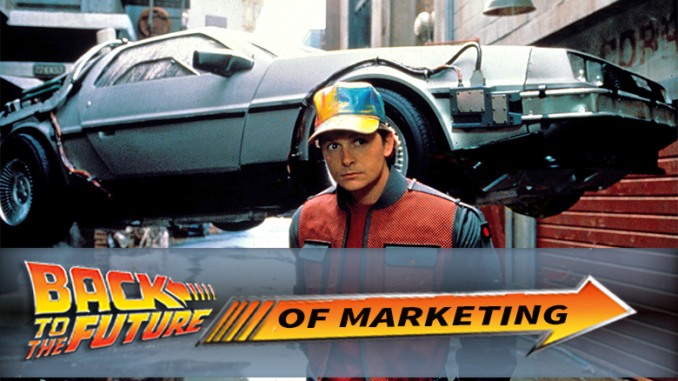
Visions of the future are often filled with a utopia of elaborate robotic contraptions and flying cars. I remember watching the Back to Future Sequel truly believing 2015 would have hover boards (not the kind that start on fire), self-lacing shoes and a flying cars. I know, technology advanced (A LOT) between 1989 and 2015, but it we’re still not quite to the age of The Jetsons.
I’m not saying this to be critical. Rather, I’d like to point out that space-age technology appears to be an evolution, not a revolution. I feel marketing is the same way, even digital marketing. We have the internet and it has truly changed how we reach and influence our target audience… and I feel there is far more to come. So what’s next?
Thinking ahead to 2020 sounds far away. Probably because it’s the beginning of a new decade. And for people like me who are on the more “mature” side of the Millennial Generation, 2020 sounds much farther than 4 years ahead. Knowing change is evolution, not revolution, as I learned by way of the Back to the Future franchise… I recognize the likelihood of a marketing epiphany is unlikely between now and 2020. However, I do believe you will see marketing will to continue to mature in this not-so-distant future and delivering a greater impact through your online channels. As a digital marketer, I’m willing to make three predictions for what you will see in the year 2020.
1. More Personalization
Marketers understand how personalization can be highly effective, however it’s still a relatively underutilized strategy. Don’t believe me, just take a look at the current state of personalization in marketing.
You see, there is a serious lack of personalization in current marketing activities. Similar surveys increased campaign performance with personalization. Not only that, it’s an expectation from consumers.
How Personalization Will Change Between Now and 2020
Personalization requires strategy, time and resources. Brands will invest in software that makes smart and adaptive content possible. They will also recognize that personalization requires an advanced understanding of their consumer and better planning. Consumer journey mapping and segmentation will become essential elements in every marketing campaign.
2. Journey Mapping After the Point Sale
Before I assume all readers are familiar with customer journey maps, let me take a step back and provide some baseline info. Customer journey maps are a complete framework illustrating all the stages consumers experience when interacting with your brand. In many ways, this is the classic sales funnel that has transformed into a graphic that resembles a Candy Land board game. It’s a visual display of your marketing strategy and communication points to your target audience with the end goal of converting consumers to buy.
How Journey Mapping Will Change Between Now and 2020
Journey mapping is a successful strategy. It helps brands personalize the consumer experience and proactively communicate with their target audience. Tracking consumers unpredictable buying behavior requires a deep understanding of your consumers and data to support your opinions. It’s not a small task by any means, and too often brands stop the journey map – or at least the fulfillment of marketing tactics at the point of sale.
In the future, you will see brands create strategies to convert repeat, brand loyal business after the point of sale. Careful, this won’t work with every product, but it especially does with larger, long-term purchases. Think of it this way, if you know the lifecycle of your product is 2 years, you now have the ability to complete a journey mapping strategy that aligns to the depreciation of the exact date they bought the product, and know when they need a replacement.
3. Ability to Predict and Deliver ROI
Data will finally deliver what everyone wants – the ability to predict the outcome of any marketing campaign. The future of marketing will be filled with predictive analytics. If that sounds like a familiar term, it is. Predictive analytics has uses as an actuarial science for a long time. Insurance companies use it to predict risk, financial companies use it to approve loans. Digital marketing now provides enough data for marketers to accurately predict their ROI from specific strategies and campaigns.
How Marketing ROI Will Change Between Now and 2020
When many people think of advertising, they think about Mad Men and Don Draper’s creative solutions for nearly any brand. Well the era of traditional Mad Men advertising is transitioning to digital. Agencies and marketers will stop leading with creative ideas. Rather they will shift towards providing business value, which is just another way of saying ROI. Data and smart strategy will be the focus, because the data gathered from marketing campaigns will accurately predict a brand’s ROI from any digital campaign. And honestly, this is happening now, but by 2020 IBM Watson Analytics will be the new normal for marketers.
In the year 2020
We will not have flying cars and many other space-age gadgets made popular by TV and movies. But our marketing will evolve to the point where brands will know us like our neighbors. The century old adage of Half the Money I Spend On Advertising is Wasted will cease to exist, as marketers will have the answer, always. In many ways, I will enjoy this more than a flying car. And yes, I’m afraid of heights, but digital marketing is still way cooler!
